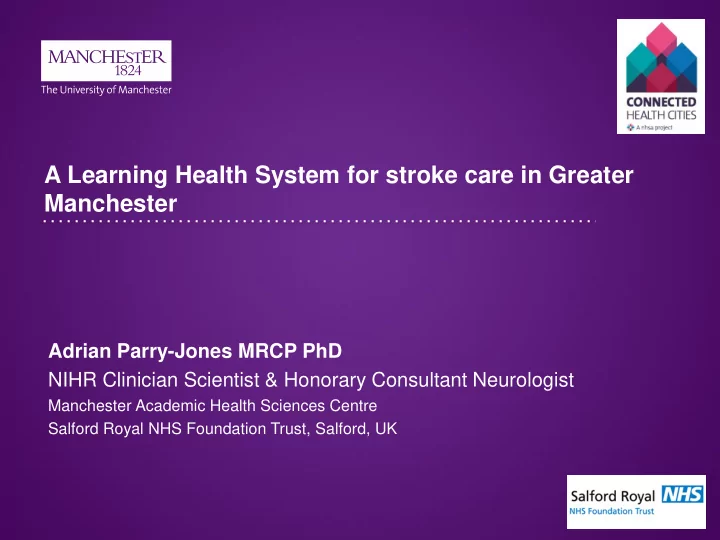

A Learning Health System for stroke care in Greater Manchester Adrian Parry-Jones MRCP PhD NIHR Clinician Scientist & Honorary Consultant Neurologist Manchester Academic Health Sciences Centre Salford Royal NHS Foundation Trust, Salford, UK
Stroke: a common problem In the UK: • 152,000 strokes/year • 1.2 million stroke survivors • £9 billion in economic costs (£4.38 billion health/social) Poor outcomes: • 1 in 8 die by 30 days • Survivors: • ½ have a disability • ⅓ dependent
Stroke: causes Ischaemic stroke: • 80-85% of strokes • Occlusion of artery • Clots from heart and neck arteries Intracerebral haemorrhage: • 10-15% of strokes • Rupture of artery with bleeding in to brain
Stroke: treatments Ischaemic stroke (80-85%): • Acute care : Stroke unit, reperfusion (thrombolysis/ clot retrieval), prevention of complications (DVT, infections) • Secondary prevention : antiplatelets, statins, blood pressure, AF – anticoagulation, carotid surgery Intracerebral haemorrhage (10-15%): • Acute care : Stroke unit, reverse anticoagulation, blood pressure control, neurosurgery • Secondary prevention : blood pressure, review antithrombotics, identify vascular malformations
Greater Manchester stroke pathway Illustration courtesy of Greater Manchester Stroke Operational Delivery Network
Stroke Units in Greater Manchester • Hyperacute Stroke Units (HASUs): Salford, Bury, Stockport • All other acute hospitals are District Stroke Centres (DSCs)
Greater Manchester stroke pathway 1 2 3 Illustration courtesy of Greater Manchester Stroke Operational Delivery Network
Workstream 1: Stroke mimics • GM Stroke ODN Audit Jan 2016 : • 480 of 969 patients assessed were strokes (49.5%) • 79% of patients arrived by ambulance • 70% of mimics arrived by ambulance
Workstream 1: Stroke mimics • Aims: 1. Describe patient flow and understand predictors for stroke mimics using existing health data • North West Ambulance Service (Stroke database, C3 dispatch system) • DataWell (Salford, Central, South) 2. Test changes to improve system • Individual feedback, telephone access to on-call stroke teams, decision support systems • Rapid assessment of impact via established data flows (once NWAS EPR in place)
Workstream 2: ICH care bundle & pathway • Common health problem ‒ Causes 10-15% of strokes ‒ More common in southeast Asian populations • Poor patient outcomes ‒ Case fatality up to 40% at 1 month ‒ Causes 5.8% of all global deaths ( vs. 6.0% for ischaemic stroke) ‒ Only 20% regain independence ‒ Little improvement in outcomes over last 30 years GBD Study 2013 collaborators(2015) Lancet 386:743 – 800; van Asch et al.(2014) Lancet Neurol 9:167-176
Workstream 2: ICH care bundle & pathway ABC Care bundle: A – anticoagulant reversal B – blood pressure control C – care pathway Salford QI project: 30-day case-fatality • 34.3% before • 25.1% after Fall of 9.2% N=216 before (May 2014 – May 2015) N=311 after (Jun 2015 – Jul 2016)
Workstream 2: ICH care bundle & pathway Aim: Reduce death and severe disability after intracerebral haemorrhage in Greater Manchester by 10% by April 2018 Objectives: 1. Analysis of historic dataset to refine care pathway 2. Automated GM intracerebral haemorrhage registry 3. Development of app and dashboard to deliver bundle 4. Planed bundle launch April 2017 Funded by the Heath Foundation: Innovating for Improvement
Workstream 3: Secondary prevention • Blood pressure: • Causes 50% of ischaemic strokes • Principal risk factor for intracerebral haemorrhage • Guidelines suggest lowering to below 130 mmHg • Atrial Fibrillation: • Accounts for up to 15-20% of strokes • Caries high risk of further stroke ~ 12% p.a. • Anticoagulation prevents 65-70% of strokes
Workstream 3: Secondary prevention Recurrent events: • Happen early • Some preventable Possible problems? • AF detection • Anticoagulation • Control of blood pressure Amarenco et al, N Eng J Med 2016, 374: 1533-42
Workstream 3: Secondary prevention Aim: Reduce the rate of recurrent strokes by rapid delivery of secondary prevention Objectives: 1. Describe AF and hypertension detection and management using existing health data • SIR & SSNAP • DataWell (Salford & Central acute trusts and CCGs) 2. Test changes to improve system • Enhanced role for ESD nurses, pharmacists • Technology for patient self monitoring and detection • Extended role for Stroke Association Co-ordinators
CHC: Stroke Project team & collaborators • University of Manchester: Adrian Parry-Jones, Goran Nenadic • Salford Royal : Pippa Tyrrell, Hiren Patel, Kyri Paroutoglou, Amit Kishore, Luca Cecchini • NIHR CLAHRC Greater Manchester : Ruth Boaden, Katy Rothwell, Lisa Dutton • GM Stroke ODN : Sarah Rickard, Chris Ashton, Jane Molloy • Stroke Association: Chris Larkin • North West Ambulance Service • Pennine Acute Hospital Trust: Khalil Kawafi • Stockport NHS Foundation Trust: Appu Suman, Shivakumar Krishnamoorthy
Recommend
More recommend